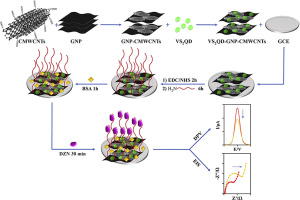当前位置:
X-MOL 学术
›
Anal. Chim. Acta
›
论文详情
Our official English website, www.x-mol.net, welcomes your
feedback! (Note: you will need to create a separate account there.)
Ultrasensitive voltammetric and impedimetric aptasensor for diazinon pesticide detection by VS2 quantum dots-graphene nanoplatelets/carboxylated multiwalled carbon nanotubes as a new group nanocomposite for signal enrichment
Analytica Chimica Acta ( IF 5.7 ) Pub Date : 2020-05-01 , DOI: 10.1016/j.aca.2020.03.047 Hossein Khosropour 1 , Behzad Rezaei 1 , Parisa Rezaei 2 , Ali A Ensafi 1
Analytica Chimica Acta ( IF 5.7 ) Pub Date : 2020-05-01 , DOI: 10.1016/j.aca.2020.03.047 Hossein Khosropour 1 , Behzad Rezaei 1 , Parisa Rezaei 2 , Ali A Ensafi 1
Affiliation

|
Polluted water and groundwater resources contaminated by pesticides are among the most important environmental distresses. Therefore, a simple, ultrasensitive, and selective electrochemical aptasensor is proposed for diazinon (DZN) determination as an organophosphorus compound. The vanadium disulfide quantum dots (VS2QDs) were synthesized by a facile hydrothermal method and doped on the graphene nanoplatelets/carboxylated multiwalled carbon nanotubes (GNP/CMWCNTs) as a new group of nanocomposite. The prepared nanocomposite (VS2QDs-GNP/CMWCNTs) on a glassy carbon electrode (GCE) was incubated with the DZN binding aptamer (DZBA) through electrostatic interaction (GCE/VS2QDs-GNP/CMWCNTs/DZBA). The modified electrode was used for the low detection of DZN by monitoring the oxidation of [Fe(CN)6]3-/4- as the redox probe. The characterizations of the modified electrode were performed by several electrochemical methods include: cyclic voltammetry (CV), differential pulse voltammetry (DPV), and electrochemical impedance spectroscopy (EIS). Also, the prepared nanocomposite was characterized with field emission scanning electron microscopy (FE-SEM), transmission electron microscopy (TEM), UV-Vis absorption spectroscopy, fourier transform infrared (FT-IR), fluorescence emission spectroscopy, dynamic light scattering (DLS), elemental mapping, and energy dispersive spectroscopy (EDS). The DZBA selectively adsorbs DZN on the modified electrode, leading to a decrease and increase in the current of DPV and charge transfer resistance (RCT) of EIS, respectively, as analytical signals. The developed electrochemical aptasensor at the optimal conditions have low limits of detection (LOD) equal to 1.1 × 10-14 and 2.0 × 10-15 mol L-1 with wide dynamic ranges of 5.0 × 10-14-1.0 × 10-8 mol L-1 and 1.0 × 10-14-1.0 × 10-8 mol L-1 for DPV and EIS calibration curves, respectively. Finally, this aptasensor had good selectivity, stability, reproducibility, and feasibility for the DZN detection in various real samples.
中文翻译:

VS2量子点-石墨烯纳米片/羧化多壁碳纳米管作为用于信号富集的新型纳米复合材料,用于检测二嗪农农药的超灵敏伏安法和阻抗法适体传感器
被杀虫剂污染的污水和地下水资源是最重要的环境问题。因此,提出了一种简单、超灵敏、选择性的电化学适体传感器,用于测定二嗪农 (DZN) 作为有机磷化合物。二硫化钒量子点(VS2QDs)是通过简单的水热法合成的,并作为一组新的纳米复合材料掺杂在石墨烯纳米片/羧化多壁碳纳米管(GNP/CMWCNTs)上。在玻碳电极(GCE)上制备的纳米复合材料(VS2QDs-GNP/CMWCNTs)与 DZN 结合适体(DZBA)通过静电相互作用(GCE/VS2QDs-GNP/CMWCNTs/DZBA)孵育。通过监测 [Fe(CN)6]3-/4- 作为氧化还原探针的氧化,修饰电极用于 DZN 的低检测。改性电极的表征通过几种电化学方法进行,包括:循环伏安法 (CV)、差分脉冲伏安法 (DPV) 和电化学阻抗谱 (EIS)。此外,制备的纳米复合材料用场发射扫描电子显微镜(FE-SEM)、透射电子显微镜(TEM)、紫外-可见吸收光谱、傅里叶变换红外(FT-IR)、荧光发射光谱、动态光散射(DLS)表征。 )、元素映射和能量色散光谱 (EDS)。DZBA 选择性地吸附修饰电极上的 DZN,分别导致 DPV 电流和 EIS 电荷转移电阻 (RCT) 的减少和增加,作为分析信号。在最佳条件下开发的电化学适体传感器具有低检测限 (LOD) 等于 1.1 × 10-14 和 2.0 × 10-15 mol L-1,具有 5.0 × 10-14-1.0 × 10-8 mol 的宽动态范围DPV 和 EIS 校准曲线分别为 L-1 和 1.0 × 10-14-1.0 × 10-8 mol L-1。最后,该适体传感器对各种实际样品中的 DZN 检测具有良好的选择性、稳定性、重现性和可行性。
更新日期:2020-05-01
中文翻译:

VS2量子点-石墨烯纳米片/羧化多壁碳纳米管作为用于信号富集的新型纳米复合材料,用于检测二嗪农农药的超灵敏伏安法和阻抗法适体传感器
被杀虫剂污染的污水和地下水资源是最重要的环境问题。因此,提出了一种简单、超灵敏、选择性的电化学适体传感器,用于测定二嗪农 (DZN) 作为有机磷化合物。二硫化钒量子点(VS2QDs)是通过简单的水热法合成的,并作为一组新的纳米复合材料掺杂在石墨烯纳米片/羧化多壁碳纳米管(GNP/CMWCNTs)上。在玻碳电极(GCE)上制备的纳米复合材料(VS2QDs-GNP/CMWCNTs)与 DZN 结合适体(DZBA)通过静电相互作用(GCE/VS2QDs-GNP/CMWCNTs/DZBA)孵育。通过监测 [Fe(CN)6]3-/4- 作为氧化还原探针的氧化,修饰电极用于 DZN 的低检测。改性电极的表征通过几种电化学方法进行,包括:循环伏安法 (CV)、差分脉冲伏安法 (DPV) 和电化学阻抗谱 (EIS)。此外,制备的纳米复合材料用场发射扫描电子显微镜(FE-SEM)、透射电子显微镜(TEM)、紫外-可见吸收光谱、傅里叶变换红外(FT-IR)、荧光发射光谱、动态光散射(DLS)表征。 )、元素映射和能量色散光谱 (EDS)。DZBA 选择性地吸附修饰电极上的 DZN,分别导致 DPV 电流和 EIS 电荷转移电阻 (RCT) 的减少和增加,作为分析信号。在最佳条件下开发的电化学适体传感器具有低检测限 (LOD) 等于 1.1 × 10-14 和 2.0 × 10-15 mol L-1,具有 5.0 × 10-14-1.0 × 10-8 mol 的宽动态范围DPV 和 EIS 校准曲线分别为 L-1 和 1.0 × 10-14-1.0 × 10-8 mol L-1。最后,该适体传感器对各种实际样品中的 DZN 检测具有良好的选择性、稳定性、重现性和可行性。











































 京公网安备 11010802027423号
京公网安备 11010802027423号